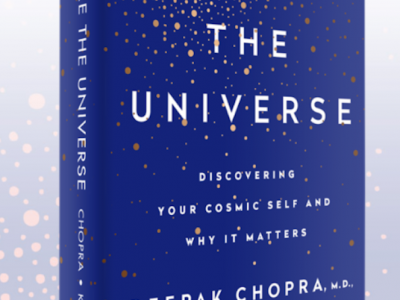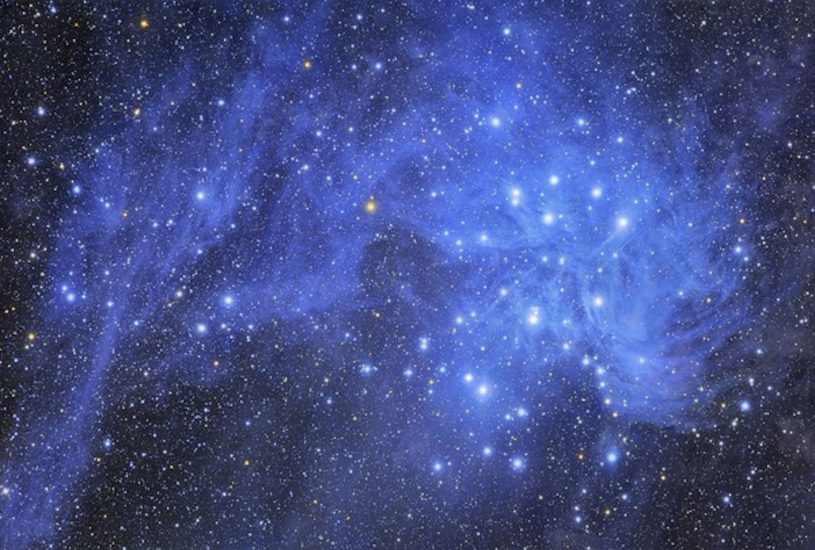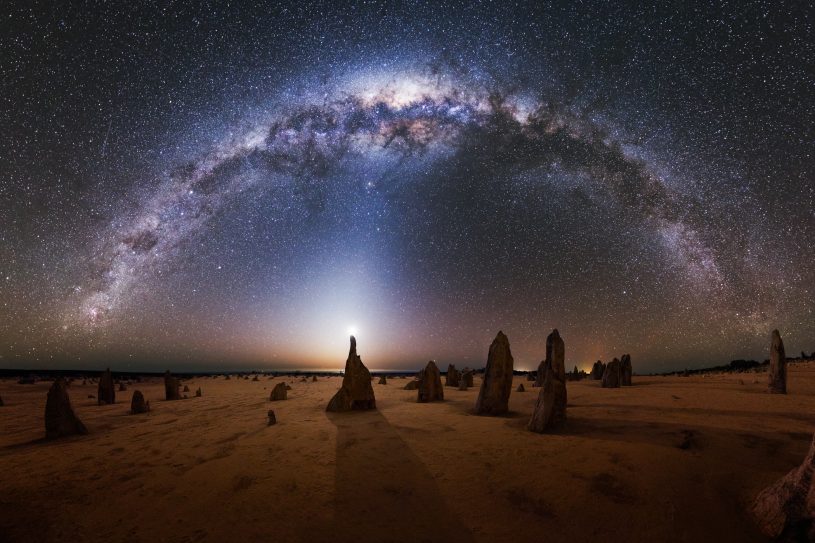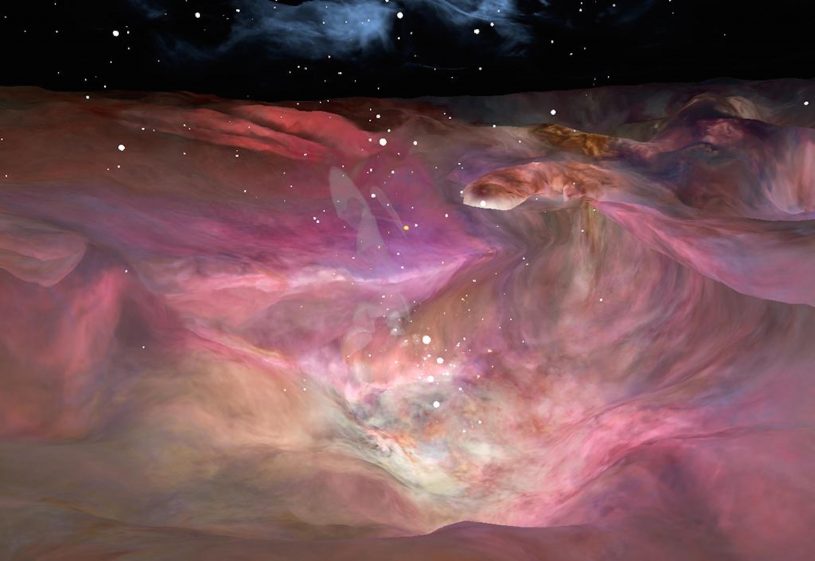An Interview with Deepak Chopra: You Are the Universe
 Claudia Welss: Welcome, Dr. Chopra. As you know, I’m with the Institute of Noetic Sciences, and we have for many years been investigating the idea that consciousness is primary and causal in the universe, as well as in our personal and shared realities.
Claudia Welss: Welcome, Dr. Chopra. As you know, I’m with the Institute of Noetic Sciences, and we have for many years been investigating the idea that consciousness is primary and causal in the universe, as well as in our personal and shared realities.
That’s had us a bit on the scientific fringe because so much of mainstream science still excludes consciousness. Your new book is pivotal because you’ve found a compelling way to introduce consciousness as fundamental to scientific inquiry. This is just in time because, as you write, “if there’s another extinction, it will be because of a science that is incomplete.” You Are the Universe supports the realization that we live in a participatory universe in which each of us has the agency to co-create our experience of reality and where every perception is an act of reality creation. So, for everyone who believes or who would like to believe that our inner landscape can be causal in transforming the outer one, You Are the Universe is a balm, bringing ages of scientific debate about the way the universe works to a credible, inspirational, and practical conclusion: the Universe is responsive to human beings.
The theme of this convergence series (see sidebar) is “Uniting the Tribes,” and reading your book reminds us that even in science there are different tribes. Could a new holistic science that includes consciousness be a uniting force, both within science itself and between science and spirituality? I feel a huge debt of gratitude for what you’re bringing into public awareness by addressing this question.
Deepak Chopra: Thank you, Claudia. It’s always a pleasure to be in conversation with you.
Welss: Thank you so much for being here, Deepak. For the most part, I’d like you to just take us wherever you’d like us to go. But I do have a few questions. To begin, I’d like to ask about the encouraging assertion you make in the book that a holistic science, one that includes consciousness, is inevitable because current scientific theories are completely stuck in their attempts to accurately describe reality and our relationship to it. And this, you say, is our most important and least attended to relationship.
Chopra: Science is struggling to explain what is called Reality. We’ve been through several iterations about what the universe is made of, who made the universe, what made the universe. We’ve been through the divine universe as explained in the book of Genesis. We’ve been through Newtonian classical physics, relativistic physics, both general theory and also special theory of relativity—quantum mechanics, eternal inflation, cosmic inflation, multiverses, on and on. None of these theories of science actually explains what Reality is or how we even know that there is something called Reality. So, the two basic mysteries of existence remain mysterious: (1) What is the true nature of existence? (2) How do we know that we exist or that something exists?
I felt it was incumbent upon me—along with the help of physicists, cosmologists, and quantum physicists including my co-author, Menas Kafatos—to really look at these two very fundamental questions. What is reality? What is existence? And how come we have awareness of that existence? That was the genesis of You Are the Universe: Discovering Your Cosmic Self and Why It Matters.
If you do a search on the Internet asking, “what are the most important or open questions in science today?,” you will find at the very top, the following questions that are open in science: (1) What is the universe made of? (2) What’s the biological basis of consciousness? (3) How did language come into existence? These three questions are intimately related.
What is the Universe Made of?
The reason it’s an open question is that we don’t know what it’s made of. The best thing we can say is that it’s made of nothing. Seventy percent of the universe is a mysterious entity called dark energy, which is a force, an anti-gravity force, that is ripping space apart and moving galaxies away from each other. So, space itself is expanding at lightning speeds. And we don’t know what this invisible force is. It doesn’t seem to be the kind of energy we speak of when we say mass is equal to energy.
Of the remaining 30% of the universe, 26% is something called dark matter, which is an invisible entity. It’s not atomic, so it does not reflect light, absorb light, emit light, or have anything to do with light. We are made of atoms; our interactions with the atomic universe are through light. And since this has nothing to do with light, although there are hypothetical particles called WIMPs, which stand for ‘weakly interactive massive particles,’ nobody knows what dark matter is made of other than it behaves like matter. It is not material. The reason it’s called matter is that it bends space-time in the same way as regular matter. So, it’s responsible for most of the gravity in our galaxy. It holds the galaxy together, including the solar system. If it wasn’t there, everything would fall apart. Planets would spin out of their orbit and the universe would disintegrate; so would we.
That leaves 4% of the universe, which is atomic, out of which 99.99% is invisible interstellar dust—mostly hydrogen and helium. So, the visible universe is .01% of all that exists, which includes hundreds of billions of galaxies, billions and billions and billions and billions of stars, and trillions and trillions and trillions of planets that are made of atoms. But this is .01%. The rest is either unknown or possibly unknowable.

The atomic universe is made up of atoms; the atoms themselves are made up of subatomic particles. When these particles are unmeasured, which means they haven’t actually been observed, they remain waves of possibility in a mathematical entity called Hilbert space. And that means they remain possibility waves in mathematical imagination. What’s the universe made of? We don’t know. The best thing we can say is nothing. What is the nothingness from which the whole universe arises, including our own self, everything that we call the body-mind, and everything that we call the physical universe?
What is the Basis of Consciousness?
The number two open question is, what’s the basis of consciousness? How do we know that we exist? How do we know the universe exists? How does the brain produce perception, sound, touch, sight, taste, smell, thoughts, feelings, emotions, memories, drives, images, imagination, introspection, intuition, and intention? Again, science has no idea. In fact, it’s a premise that the brain produces this thing called consciousness—that which makes any experience possible, whether it’s a mental experience, or a perceptual experience, or what we call the experience of physical reality.
We don’t know what consciousness is. Where is it? What is it made of? Again, consciousness doesn’t seem to have any physical form, so it’s made out of nothing as well. So, nothing is observing nothing to experience everything. This is the big conundrum that science is in at the moment. We do not know what creates experience. We do not know how we know what we know. We do not know the nature of the physical universe. And all our scientific models, even though they’re good for making calculations and creating together, they do not give us a clue to the fundamental questions of existence. Who are we? Where did we come from? Is there a God? Are we just a small speck of dust in the mindless void, in the junkyard of infinity? Or is something more meaningful going on? Right now, science is at a crossroads and cannot answer the most basic questions.
How did Language Come into Existence?
The third thing that I want to bring up right now is about language. We have language, so we can communicate our experiences with each other. Otherwise, we wouldn’t have this conversation; we wouldn’t have this discussion. We wouldn’t have a riddle. We wouldn’t have a way to even question the riddle. We wouldn’t have a way to examine the riddle of our existence. Language is very crucial to communication of experiences. Humans have both written language and oral language. But there are other kinds of language—mathematical language, language as symbolic expression and representation, communication of experiences, questions that we have, and riddles that we want to examine.
But if you ask linguists, “How did language come about?” they have no idea. Just like we have no idea how life came about, how the universe came about. Although I address all these questions in the book, about what was there before the Big Bang. How did time come into existence? Why is the universe mathematically fine-tuned to create both life and mind? We address these questions because we have language. Linguists have no idea how language came about, how it is there right now, and how it evolved to describe with words and stories the experiences that we have.
Once we have a little bit of a clue into these three questions, then we have to reexamine everything we know about Reality, everything we know about what we call existence.
Welss: Thank you, Dr. Chopra. In the book, you write about the importance of The Observer Effect in any consideration of Reality. I think it is helpful for us to understand here what The Observer Effect is.

Chopra: Well, according to at least one interpretation of quantum mechanics, which is called the Copenhagen Interpretation, until an observer is there, the universe exists as possibilities. The observer actually causes what are called ‘possibility waves’ to collapse into space-time events that we call physical matter. A quantum, which is a unit of energy and information, actually has something called mass and energy. The waves that give rise to it have neither mass nor energy. They exist in this ephemeral field of possibilities. You need an observer to actually make the world manifest.
Welss: You give a great illustration in the book by asking us to imagine coming downstairs in your house and it’s dark. All of a sudden, there’s a mouse in the corner scurrying across the floor. When he sees you observe him, he stops. That’s a simple but profound example of this effect in which the ordinary act of observing can affect the material world.
Chopra: Now, of course, that then leads into these questions, “Who’s the observer? Where is the observer? What is the observer?”
Welss: That’s actually related to my next question. Would you please address what visionary quantum pioneer Wolfgang Pauli meant when he said, “The science of the future reality will neither be psychic nor physical, but somehow both and somehow neither.” And, if it fits with your response, please say more about what you mean when you say in the book that the universe is
actually a mirror of the human nervous system.
Chopra: I’m saying that as a preliminary to something much more important. We know that the universe that we experience as human beings somehow has something to do with that which we call the human brain. We’re not experiencing the universe in the way, say, a bat would. A bat would experience the universe as the echo of ultrasound. A chameleon’s eyeballs swivel on two different axes; we can’t even remotely imagine what the universe would look like to a chameleon. A honeybee returns to its hive after visiting a flowering grove and does what is called a waggle dance to communicate where the other bees can go for honey. What we call perceptual reality is a species-specific phenomenon; there is no such thing as the look of the world. It depends on who’s looking and what nervous system they are using to do that looking.
Let’s examine that because we do not know how the brain actually produces the experience. When you’re looking at an object, how does the brain take photons that have no dimensionality or color and are all that are coming towards you and you have the experience of a three-dimensional world in space and time, with color and fragrance and texture and sound? We don’t know that. While we can say that our brain correlates with that experience, correlation does not necessarily mean causation. But we do know that a human brain produces what we call the human universe.
A dolphin brain would produce a dolphin universe. Different species have different perceptual experiences. But one thing they must share as the common ground of all experience is what we call awareness or consciousness. So, if you have a dog or a cat as a pet, or any other animal, and you have a relationship with that animal, that’s not because you’re perceiving the same perceptual reality. It’s like you are both in a virtual arcade using awareness as the interface through which you translate the experiences you’re having in human terms or dog terms or cat terms or any other species’ terms. The dog in the White House has no concept that it’s sitting in something called the White House, in something called the Oval Office, with a person called the President of the United States, who can press a button and cause nuclear warfare. Those are human concepts. And yet, you share awareness.
Awareness and consciousness is the common ground of all experience. And experiences are innumerable. Perceptual experiences are species-specific, but they’re also culture-specific and personal. There’s personal experience. There’s collective experience. There’s species experience. There’s transpersonal experience. And possibly there’s universal experience. So, what I’m saying is that you need awareness or consciousness to have experience. That experience could be a perceptual experience, in which case we call it the physical world, or it could be a mental experience or an image or a thought or an emotion. in which case we call it the mental world. But those are human constructs around experience.
You cannot separate an object from the experience of that object. If I’m looking at a cup of coffee on the mantelpiece, I cannot separate those objects from my perceptions of those objects, from my experience of those objects. So, where are those experiences occurring? They’re occurring in consciousness. Where is consciousness? We can’t find it. It doesn’t have a form. If it doesn’t have a form and you can’t find it, then it must be invisible. And being invisible, it’s not in space-time. If it’s not in space-time, then it’s eternal. It’s non-local. And so right now, we are non-local beings having a local experience where we are translating our experiences and then objectifying them as what we call “the physical body-mind and the physical world.” But the physical body-mind and the physical world are human constructs around experience. And experience is dependent on consciousness. So, if we were to define consciousness, which is not an easy thing, we would say—borrowing from many other experts in this area like Rupert Spira, Dan Siegel, and many others—consciousness is the knowing element in every subjective experience. Consciousness is that in which experience occurs and is known.
Here’s the difficult part. What is that out of which an experience is made? What is a thought made of? It’s a modified form of consciousness. What is an emotion? It’s a modification of consciousness. So, it’s made out of consciousness. Now, we don’t have any problem with this. But somehow we think our perceptions are not made out of consciousness because we call our perceptions ‘the external world.’ But perceptions are as much an activity or modification of consciousness as thoughts and emotions are. So, a sound is a modified form of consciousness. A texture is a modified form of consciousness. Taste, smell, color, form—these are modified forms of consciousness.
When you realize this, then you realize that all the building blocks of subjective experience are nothing other than sensations, images, feelings, thoughts, and sense perceptions. We objectify these as something we call the body-mind and the physical universe. When we normally think of ourselves as being in the universe, we think of ourselves as ‘me’ and the rest of the universe, and the ‘me’ is supposed to be somewhere in the body-mind. But you can’t find that ‘me’ in the body-mind because it’s not there. It’s formless.
In fact, the body-mind is as much an experience as what we call the physical world. And in raw terms, that experience is nothing but qualia, or qualities of experience, which are S-I-F-T—sensations, images, feelings, thoughts. Period. Now what we do is we create constructs around this. We objectify this experience. We call it the objective physical world. But in fact, that’s a human story. And that’s why I say you are the universe. You don’t exist in the universe. The so-called universe exists in you. You don’t exist in the body. The so-called body exists in you. You don’t exist in the mind. The so-called mind exists in you.
In other words, we are the creators of the human universe, and we’ve been doing it for centuries and millennia, but we don’t realize that we made up the whole thing. You know, we made up chairs and tables and furniture and physical objects like New York City and latitude and longitude. But we also made up stars and galaxies because stars and galaxies are nothing other than sensations, images, feelings, and thoughts, which are perturbations of consciousness.
Welss: Deepak, sometimes when I listen to you, I want to hold onto my chair. But it sounds like that really won’t help very much!
Chopra: (laughs) The chair is a construct. And Claudia is also a construct of the body-mind. The reality is a formless being that is now manifesting as Claudia, the chair, this conversation, and the phone.
About The Convergence Series
This Interview was originally an episode in The Convergence series, transcribed and edited by Kosmos Journal.The Convergence is a radio series on VoiceAmerica hosted by Dr. Kurt Johnson, a frequent contributor to Kosmos Journal, co-author of The Coming Interspiritual Age, and author of several books on the interface of spirit, art, and science. Sponsored by a collective of global Interfaith and transformative change organizations, the initial 13 episodes ran from the UN’s Week of Spirituality (November 2016) to the UN’s Week of Interfaith Harmony (February 2017). They centered on the theme “Waking Up and Growing Up,” a vision uniting the heart of our world’s Great Wisdom Traditions with the 17 areas of the UN’s Sustainable Development Goals. Following a framing by integral philosopher Ken Wilber, Deepak Chopra was hosted by the Institute of Noetic Science’s Claudia Welss for a discussion of consciousness and the new holistic science. Series episodes have included thought leaders Karenna Gore, Luisah Teish, Brian McLaren, Stephen Dinan, Fr. Thomas Keating, Gregg Braden, Duane Elgin, James O’Dea, Cynthia Bourgeault, Diane Williams, Deborah Moldow, Myra Jackson, David Sloan Wilson, David Spangler, David Nicol, Tim Wise, and Michael Dowd.

Welss: You divide perception into three categories in the book. Can you tell us what those three categories are?
Chopra: The categories are perceptual categories, which we call the physical. But then we have a category called mental. And then we have a whole category called causal or spiritual. But again, these are ways of dividing an undivided wholeness.
Welss: To introduce my next question, I’ll just add three other categories from your book: perceptions we can change, perceptions we can’t change, and perceptions that are sometimes changeable and sometimes not. In your Facebook Live post after the US election, you advised that we have to face Reality. What does that mean, in a universe where Reality is somewhat malleable? And how deep does our agency to co-create Reality really go? Part two of that question would be this: in a universe where, as you just said, the fundamental building blocks of Reality are subjective experience, and in a world where there seems to be no objective truth, where do we find our moral compass?
Chopra: It’s not an easy thing to do, Claudia, because, as you know, we are bamboozled by the hypnosis of what we call social conditioning. And then we are part of that social conditioning. So, most of the thoughts you have are not your own. They’re recycled thoughts of society. And they’ve been recycling for centuries. What we call everyday reality is indeed a social construct, and our thoughts don’t belong to us, just like the molecules of our body don’t belong to us. They’re recycling in the entire ecosystem of what we call existence.
First of all, you have to accept the common reality. Otherwise, you wouldn’t be able to participate in it. There’s a motley group of sages, psychotics, geniuses, and rebels who are not part of this collective hypnosis. And we don’t treat them too kindly. We either crucify them or they’re outcasts of society or they’re considered insane.
We have to accept our common reality, perceptual experience, and the construct around it, if you want to survive in this world. But then having done so, participating in the social constructs so we can engage in conversation and politics and economics and social injustice and economic injustice and face the problems of climate change, we have to expand the conversation from a personal point of view to a more holistic point of view where we don’t have the subject-object split, which is ‘me’ and the universe. Actually, ‘me’ is an activity of the universe. So, we are all one holistic activity.
That realization could give rise to a new science of consciousness, which would look at creating technologies that would not be destructive. We would not mechanize death and atom bombs and nuclear weapons, and we would not cause climate change and eco-disruption and extinction of species. We do need a holistic science.
We need to also address fundamental questions about human suffering and things that humans dread, like old age, infirmity, and death, as well as the meaning and purpose of existence itself. We cannot do that if we buy into the collective construct. The wisdom traditions say that human suffering comes from not knowing the true nature of Reality. It comes from grasping and clinging to things that are in time and therefore impermanent. It comes from being afraid of impermanence. It comes from identifying with another construct called ‘the ego,’ which is a socially induced hallucination, and finally, it comes from the fear of death.
We have to address these and then go deeper into a more fundamental existence where we recognize ourselves as timeless beings, as formless consciousness having the experience of form. We are non-local beings having a local experience or human experience in time and space. The more we can shift our identity from our ego-bound personalities to the source of consciousness in which those are constructed, the more we can question our constructs.

The more we can question our interpretations of what a thought is, what a feeling is, what a sensation means, what a perception means, the more we can move into that collective domain where we can experience ourselves as an expression of divine creative intelligence and the more we will alleviate suffering in the world.
There are two levels of understanding human suffering. One is very practical. Feed the hungry. Work for social justice, economic justice, sustainability, economic upliftment, or for the welfare of all sentient beings. But there’s another level where we have to question the constructs that give us the experience of the everyday world and then become the authors, collectively, of the next stage of evolution of the human species. This would be literally participating in the evolution of the universe because the universe is a projection of our consciousness.
There are four principles that I’ve found very useful to live by. One is that everything that you’re experiencing is a projection of your conditioned mind. So, it’s representing who you are and where you are in your evolution. Number two, the real you was never born because it’s not in time and, therefore, it’s not subject to death. Number three, the fundamental nature of all existence is that it is without ego, and when you can go to that level, you can be free. And number four, if you can name it and you can experience it, it’s not you. You are the one who is doing the naming and the experiencing.
Welss: Thank you, Deepak. I can’t think of a more empowering message. And thank you so much for bringing up freedom. We recognize how important our ability to be free selves is to our capacity to be a healing force on the planet. I feel this is the conversation of our lifetime and could continue for a lifetime. And so I’m glad to hear, Deepak, that you’ll be teaching a course on this book.
The American anthropologist Loren Eiseley said, “He who seeks naively to embrace his own time will accept its masks and illusions.” I want to thank you so much, Deepak, for helping us see through the masks and illusions of our time. And thank you, Kurt, for all your contributions to the same.
Chopra: Thank you, Claudia.
* This article is an edited version of an interview in the Convergence Series, directed by Kurt Johnson. Click here for more information.

Elegantly expressed. Beautiful. Breathtaking.
Great interview, Kosmos – as usual! Thank you for your work!
Excelente nota! Felicitaciones a Claudia y al Dr. Deepak Chopra. Gracias por compartir esta entrevista!
Amazing such Simple and clear and easy absorb it